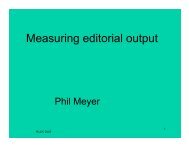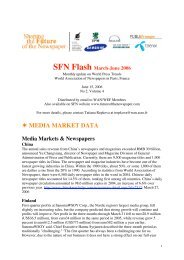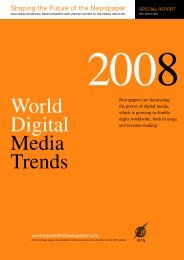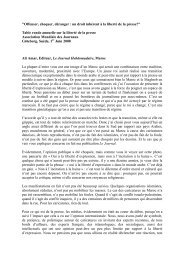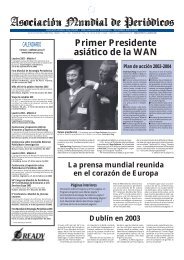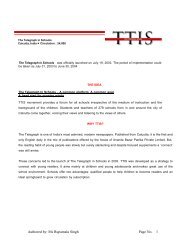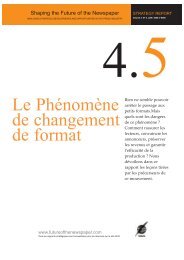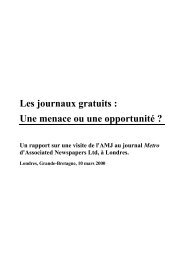WORLD PRESS TRENDS - World Association of Newspapers
WORLD PRESS TRENDS - World Association of Newspapers
WORLD PRESS TRENDS - World Association of Newspapers
You also want an ePaper? Increase the reach of your titles
YUMPU automatically turns print PDFs into web optimized ePapers that Google loves.
ADVERTISING<br />
ADVERTISING<br />
Newspaper ad expenditure and newspapers’ share <strong>of</strong> the ad market<br />
US$ million (current prices)<br />
120,000<br />
100,000<br />
80,000<br />
60,000<br />
40,000<br />
20,000<br />
0<br />
45.0<br />
40.0<br />
35.0<br />
30.0<br />
25.0<br />
%<br />
20.0<br />
15.0<br />
10.0<br />
5.0<br />
0.0<br />
1990<br />
1991<br />
1992<br />
1993<br />
1994<br />
1995<br />
1996<br />
1997<br />
1998<br />
1999<br />
2000<br />
2001<br />
2002<br />
2003<br />
2004<br />
2005<br />
Ad expenditure (left hand scale)<br />
Market share (right hand scale)<br />
Every six months ZenithOptimedia collects advertising<br />
expenditure figures from 57 countries around the world,<br />
including forecasts for the next few years. We estimate<br />
that total advertising expenditure shrank by 3.6% between<br />
2000 and 2002, as companies had to cope with falling<br />
pr<strong>of</strong>its and lower expectations <strong>of</strong> future growth.<br />
Newspaper ad expenditure fell faster: by 7.5%, we<br />
estimate. The downturn hit hardest in the large,<br />
developed ad markets, when the bubbles <strong>of</strong> exuberance<br />
in the dotcom, IT and telecommunications sectors burst<br />
so dramatically in 2001. Several <strong>of</strong> the developing markets<br />
escaped the advertising downturn almost entirely. These<br />
smaller markets tend to spend much more on television<br />
and less in newspapers, so their relative strength shifted<br />
a portion <strong>of</strong> world ad expenditure from the latter to the<br />
former.<br />
<strong>Newspapers</strong>’ share <strong>of</strong> the world ad market fell from 32.1%<br />
in 2000 to 30.8% in 2002. This was a particularly sharp<br />
instance <strong>of</strong> the long decline in newspapers’ market share,<br />
which has been going on for as long as we have been<br />
collecting data. As the above chart shows, however, over<br />
the long term the amount spent on newspaper advertising<br />
has grown quite substantially, if erratically; even after two<br />
years <strong>of</strong> decline newspaper ad expenditure was higher in<br />
2002 than it was in 1999. <strong>Newspapers</strong>’ loss <strong>of</strong> share is<br />
largely the result <strong>of</strong> the growth <strong>of</strong> other media, <strong>of</strong>fering<br />
advertisers new opportunities, rather than a decline in<br />
newspapers themselves. During the 1980s and 1990s<br />
television markets across the world deregulated, allowing<br />
television to supply audiences to advertisers more<br />
efficiently. The internet, <strong>of</strong> course, has created an entirely<br />
new form <strong>of</strong> advertising, and even outdoor, which may<br />
seem a quintessentially old medium, is improving as<br />
contractors develop new types <strong>of</strong> display.<br />
<strong>Newspapers</strong> are innovating too, developing special<br />
sections to capture new readers and provide a platform<br />
for specialist advertisers, and refining their editorial<br />
content and design. Notably, newspapers have made<br />
creative use <strong>of</strong> the internet to extend their paper activities.<br />
Many have developed large databases <strong>of</strong> classified<br />
advertising, <strong>of</strong>ten in partnership with other newspapers<br />
owned by the same publisher, or with other publishers.<br />
This was partly a defensive reaction to the emergence <strong>of</strong><br />
purely online classified advertising, but also a way to<br />
extend the reach and value <strong>of</strong> their existing classified<br />
advertising businesses, which for many local newspapers<br />
were previously confined to small distribution areas. This<br />
sort <strong>of</strong> advertising is subsumed within general internet<br />
advertising, not captured in the newspaper ad<br />
expenditure figures cited above, but it provides publishers<br />
with a useful second stream <strong>of</strong> income and a means to<br />
promote their main paper products.<br />
It is true that newspaper circulation is declining in the<br />
developed world, as we describe later in the ‘Titles and<br />
circulations’ section. But it is growing quite rapidly in<br />
the developing world, which holds most <strong>of</strong> the world’s<br />
population. There is no sign that overall demand for<br />
newspapers is under any long-term threat, and while<br />
people continue to read newspapers, advertisers will want<br />
to use newspapers to reach them.<br />
2<br />
<strong>WORLD</strong> ASSOCIATION OF NEWSPAPERS - <strong>WORLD</strong> <strong>PRESS</strong> <strong>TRENDS</strong> 2003




